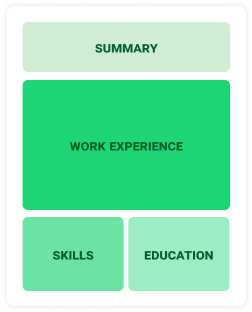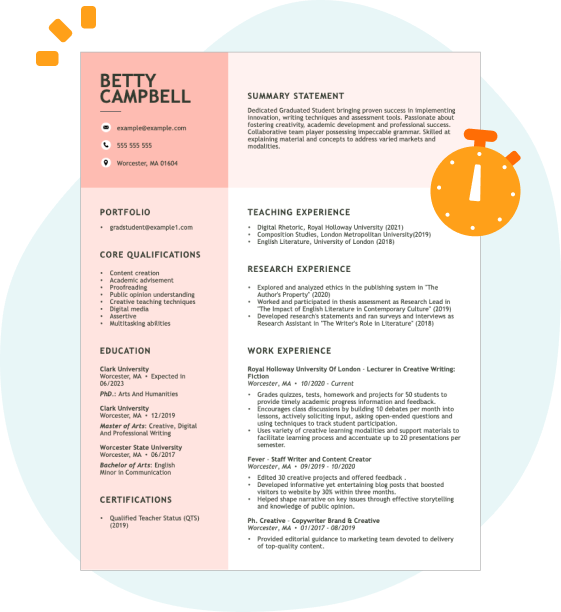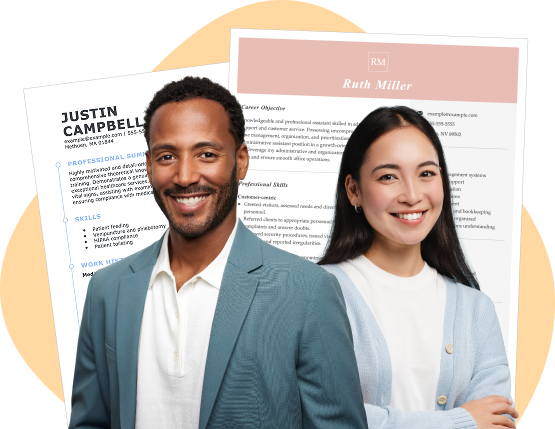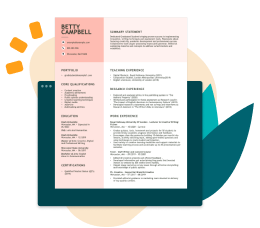Hard skills encompass design software expertise, material knowledge, and craftsmanship techniques, all of which are essential for creating functional and aesthetically pleasing furniture.
Popular Furniture Designer Resume Examples
Check out our top furniture designer resume examples that emphasize creativity, craftsmanship, and innovative design solutions. These samples illustrate how to effectively showcase your unique skills and accomplishments in the industry.
Ready to build your standout resume? Our Resume Builder offers user-friendly templates specifically designed for furniture designers, helping you make a lasting impression.
Entry-level furniture designer resume
This entry-level resume effectively highlights the job seeker's design skills and notable achievements, such as custom furniture projects and improved production efficiency. New professionals in this field must convey their creativity, technical skills, and ability to work collaboratively with clients to stand out to potential employers despite having limited experience.
Mid-career furniture designer resume
This resume effectively showcases qualifications by highlighting the applicant's extensive experience and innovative design skills. The emphasis on client satisfaction and efficiency improvements illustrates a clear trajectory towards leadership roles in furniture design, indicating readiness for complex challenges.
Experienced furniture designer resume
This resume's work history section illustrates the applicant's strong background in furniture design, highlighting their success in creating over 50 pieces that boosted sales by 20% and optimizing processes to reduce production time by 30%. The concise bullet points facilitate quick comprehension for hiring managers.
Resume Template—Easy to Copy & Paste
Sophia Park
Riverside, CA 92502
(555)555-5555
Sophia.Park@example.com
Professional Summary
Accomplished Furniture Designer with nine years' expertise in innovative design. Proven track record in customer satisfaction and efficient use of materials. Adept in eco-friendly practices, combining artistry with practicality.
Work History
Furniture Designer
Artisan Designs Co. - Riverside, CA
January 2023 - October 2025
- Created furniture designs increasing sales by 25%
- Led a team to develop eco-friendly furniture line
- Enhanced client satisfaction by 35% via custom solutions
Interior Furnishings Specialist
HomeStyle Creations - San Francisco, CA
January 2019 - December 2022
- Developed modular designs boosting space use by 40%
- Collaborated with clients increasing retention by 20%
- Introduced sustainable materials reducing costs by 15%
Furniture Design Associate
Elegant Living Designs - San Diego, CA
January 2016 - December 2018
- Assisted in conceptual designs raising efficiency by 30%
- Analyzed trends optimizing product offerings by 18%
- Managed client projects reducing delivery time by 20%
Languages
- Spanish - Beginner (A1)
- French - Intermediate (B1)
- Italian - Beginner (A1)
Skills
- 3D Modeling
- Keen Aesthetic Sense
- CADD Software Proficiency
- Trend Analysis
- Material Knowledge
- Client Communication
- Sustainable Design
- Project Management
Certifications
- Certified Furniture Designer - Furniture Design Institute
- Sustainable Design Professional - Green Certification Board
- Advanced CADD Techniques - Creative Tech Academy
Education
Master of Fine Arts Furniture Design
Arizona State University Tempe, Arizona
May 2015
Rhode Island School of Design Providence, Rhode Island
May 2013
How to Write a Furniture Designer Resume Summary
Your resume summary is the first impression employers have of you, so it should effectively showcase your unique design talents and experiences. As a furniture designer, you need to highlight your creativity, technical skills, and ability to understand client needs.
In this role, it's essential to emphasize your understanding of materials, craftsmanship, and innovative design solutions. This will help differentiate you from other job seekers who may lack this focus.
To illustrate what makes an effective resume summary for a furniture designer, we’ll provide examples that demonstrate successful strategies and common pitfalls:
Weak resume summary
I am a creative furniture designer with years of experience in the industry. I seek a position where I can use my skills and passion for design to contribute to projects. A role that allows me to express my creativity while being part of a successful team is what I’m looking for.
- Lacks specific details about the job seeker’s unique skills and contributions in furniture design
- Overuses personal language, making it feel less professional and more generic
- Emphasizes what the job seeker desires from the job rather than highlighting their potential value to the employer
Strong resume summary
Innovative furniture designer with 7+ years of experience in residential and commercial interiors, specializing in sustainable materials and ergonomic design. Increased client satisfaction ratings by 25% through personalized design solutions and careful attention to detail. Proficient in CAD software, 3D modeling, and project management, ensuring timely delivery of high-quality products.
- Begins with a clear indication of experience and specialty areas relevant to furniture design
- Highlights quantifiable achievements that demonstrate a positive impact on client satisfaction
- Mentions technical skills that are essential for success in the furniture design industry
PRO TIP
Showcasing Your Work Experience
The work experience section is important in your resume as a furniture designer, containing the bulk of your content. Good resume templates always ensure this section stands out prominently.
This area should be organized in reverse-chronological order, listing your previous positions clearly. Use bullet points to highlight key achievements and projects you've completed that showcase your design skills and innovation.
Now, let's look at a couple of examples that illustrate effective entries for furniture designers. These will clarify what practices are beneficial and which should be avoided:
Furniture Designer
DesignCo – Los Angeles, CA
- Created furniture designs
- Worked with clients to understand needs
- Used software for design planning
- Collaborated with a team on projects
- Lacks specific details about the types of furniture designed
- Bullet points do not showcase unique skills or achievements
- Focuses on general tasks rather than innovative contributions or measurable outcomes
Furniture Designer
Elegant Interiors – New York, NY
March 2020 - Current
- Develop unique furniture concepts that align with client needs and current design trends, improving customer satisfaction ratings by 30%
- Use sustainable materials in 80% of projects, contributing to a 40% reduction in overall production waste
- Collaborate closely with manufacturers to optimize production processes, decreasing lead times by 15%, ensuring timely delivery of products
- Starts each bullet point with powerful action verbs that highlight the designer's contributions
- Incorporates specific metrics to showcase tangible results from the job seeker's efforts
- Demonstrates relevant skills like sustainability and collaboration that are essential in furniture design
While the resume summary and work experience are important components of your resume, don’t overlook other sections that also deserve careful attention. For more in-depth advice on crafting a standout resume, be sure to explore our comprehensive how to write a resume guide.
Top Skills to Include on Your Resume
A well-defined skills section is important for a furniture designer's resume. This segment allows potential employers to quickly gauge your qualifications and the specific competencies you bring to the table.
Employers want candidates who bring both technical know-how and strong people skills to the table. As you write your resume, make sure to highlight a balanced mix of hard and soft skills that reflect your full professional strengths.
Soft skills, such as creativity, collaboration, and attention to detail, play a significant role in understanding client needs and ensuring successful project outcomes through teamwork.
When selecting your resume skills, it's important to align them with what employers expect from an applicant. Many organizations implement automated systems to filter out applicants who lack essential skills for the position.
To ensure your resume stands out, take time to review job postings closely. They often highlight the specific skills that recruiters value most, helping you tailor your application to meet both human and ATS requirements.
PRO TIP
10 skills that appear on successful furniture designer resumes
To capture the interest of potential employers, it’s important to highlight skills that are in high demand for furniture designers. Our resume examples showcase these abilities, helping you present yourself professionally and confidently when applying for jobs.
By the way, be sure to include skills from the following list if they align with your experience and job requirements:
Creativity
Attention to detail
Technical drawing
Material knowledge
Sustainable design practices
3D modeling software skill
Project management
Client communication
Problem-solving
Trend awareness
Based on analysis of 5,000+ interior design professional resumes from 2023-2024
Resume Format Examples
Selecting the appropriate resume format is important for furniture designers, as it showcases your design expertise, relevant projects, and unique style that set you apart in a competitive industry.
Functional
Focuses on skills rather than previous jobs

Best for:
Recent graduates and career changers with limited experience in furniture design
Combination
Balances skills and work history equally

Best for:
Mid-career professionals looking to highlight their skills and growth potential
Chronological
Emphasizes work history in reverse order

Best for:
Innovators transforming spaces with unique, sustainable designs
Frequently Asked Questions
Should I include a cover letter with my furniture designer resume?
Absolutely, including a cover letter can significantly improve your application. It allows you to showcase your personality and elaborate on your relevant skills. For tips on crafting an effective cover letter, explore our resources on how to write a cover letter or use our Cover Letter Generator for a quick start.
Can I use a resume if I’m applying internationally, or do I need a CV?
When applying for jobs abroad, a CV is typically preferred over a resume. Use a CV when the position requires detailed information about your academic and professional history. For guidance on how to write a CV effectively, explore our comprehensive resources tailored for international job seekers. Additionally, you can review various CV examples to better understand the format and content that will make your application stand out.
What soft skills are important for furniture designers?
Soft skills such as creativity, communication, and collaboration are essential for furniture designers. These interpersonal skills enable them to understand client needs, work effectively with teams, and innovate designs that resonate with users, ultimately improving the overall design process and product satisfaction.
I’m transitioning from another field. How should I highlight my experience?
Highlight your transferable skills such as creativity, project management, and teamwork when applying for furniture designer roles. These abilities demonstrate your potential to innovate and collaborate effectively, even if your background is in a different industry. Provide specific examples to illustrate how experiences from your past can translate into valuable contributions within the design field.
Where can I find inspiration for writing my cover letter as a furniture designer?
If you're a furniture designer seeking inspiration for your cover letter, consider exploring our curated collection of cover letter examples. These samples can provide valuable content ideas, formatting tips, and effective ways to showcase your design skills and qualifications to potential employers.
How should I format a cover letter for a furniture designer job?
To format a cover letter, start with your contact details and a professional greeting. Next, craft an engaging opening paragraph that captures attention. In the body, clearly outline your qualifications while ensuring they align with the job description. Conclude with a strong closing statement that encourages further discussion about your application.







